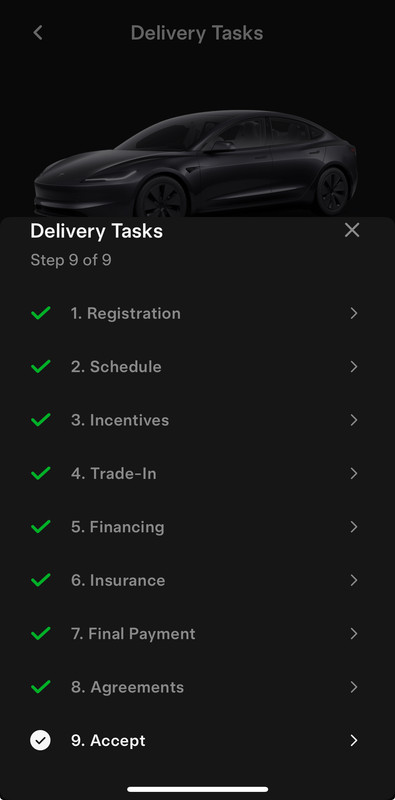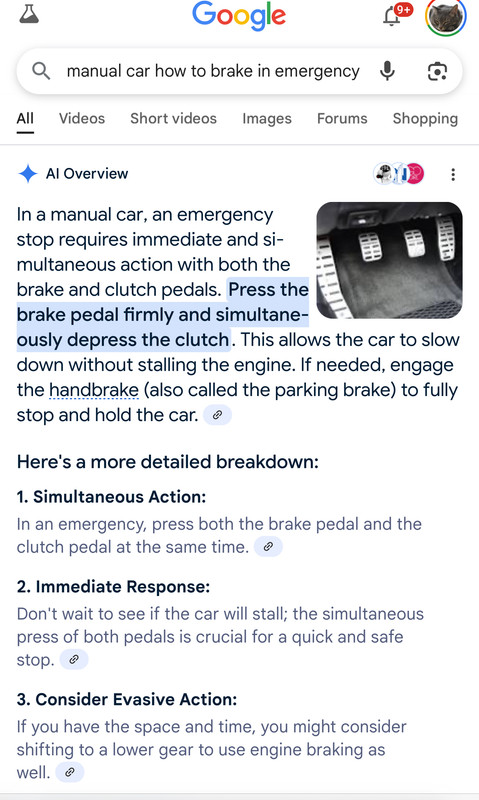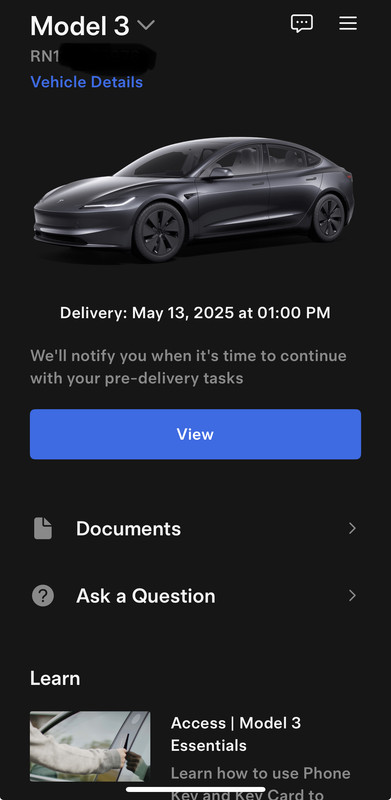又搞了辆tesla
版主: lexian
-
cellcycle1
- 论坛元老

cellcycle1 的博客 - 帖子互动: 996
- 帖子: 69407
- 注册时间: 2022年 7月 24日 15:59
#43 Re: 又搞了辆tesla
别偷窥啊,,ignius 写了: 2025年 5月 12日 18:58 lease了一辆model 3 long range rwd,给大儿子开两年。
把儿子和他女友高兴坏了,俩个人都很喜欢tesla。
现在有0 down,$349一个月的lease deal。我算了一下apr差不多2.76%,比CD还低,可以接受。还能通过app随时监控儿子的动向。哈哈。 明天去提车。

#48 Re: 又搞了辆tesla
没错 我开了十几年手动 都是这么操作的ignius 写了: 2025年 5月 13日 13:20 https://zhuanlan.zhihu.com/p/33156616
首先说,遇见紧急情况只踩刹车不踩离合会有什么影响!
如果只踩刹车不踩离合,那么发动机可能会熄火!驾驶手动挡车型最怕的就是熄火,当遇到事故紧急制动停下来时,并不意味着成功地躲避了危险,反而有可能会发生二次发生危险,而这时车子已经熄火了,想快速起步躲避显然已经来不及了。
再有,遇见紧急情况相信很多人都难以保持冷静,如果这个时候再误操作,把油门当刹车踩,那后果真的不堪设想!当然,这都是小概率事件,但凡是都有万一。
还有汽车的ABS,也就是防抱死系统会受到影响,不踩离合器的情况下,额外的制动力可能会影响ABS系统的正常工作,在极端的情况下可能会影响操控性,比如紧急避让动作的效果缓慢或者没反应等。
其实,刹车的同时踩下离合,制动距离并没有比只踩刹车短多少,但前者是更安全的做法。一来可以避免车子熄火,二来当紧急制动误踩油门时,我们踩下离合还有一次补救机会!
总之,需要记住的就一点:手动挡车型紧急制动时,刹车、离合器同时踩!虽然出现紧急制动的情况也是极少数,但往往一个细节就决定了事情的走向,一定要注意细节!
紧急的时候肯定是刹车离合同时踩
如果只踩刹车都是轻踩刹车
x1
 x1
x1

 x1
x1

#50 Re: 又搞了辆tesla
ignius 写了: 2025年 5月 13日 13:20 https://zhuanlan.zhihu.com/p/33156616
首先说,遇见紧急情况只踩刹车不踩离合会有什么影响!
如果只踩刹车不踩离合,那么发动机可能会熄火!驾驶手动挡车型最怕的就是熄火,当遇到事故紧急制动停下来时,并不意味着成功地躲避了危险,反而有可能会发生二次发生危险,而这时车子已经熄火了,想快速起步躲避显然已经来不及了。
再有,遇见紧急情况相信很多人都难以保持冷静,如果这个时候再误操作,把油门当刹车踩,那后果真的不堪设想!当然,这都是小概率事件,但凡是都有万一。
还有汽车的ABS,也就是防抱死系统会受到影响,不踩离合器的情况下,额外的制动力可能会影响ABS系统的正常工作,在极端的情况下可能会影响操控性,比如紧急避让动作的效果缓慢或者没反应等。
其实,刹车的同时踩下离合,制动距离并没有比只踩刹车短多少,但前者是更安全的做法。一来可以避免车子熄火,二来当紧急制动误踩油门时,我们踩下离合还有一次补救机会!
总之,需要记住的就一点:手动挡车型紧急制动时,刹车、离合器同时踩!虽然出现紧急制动的情况也是极少数,但往往一个细节就决定了事情的走向,一定要注意细节!
不好意思,只能说你以前学的是错的。我从来没有说不踩离合啊,我说的是带着档踩刹车,速度降下来再离合。离合刹车同时踩是很危险的。
怪不得你这么喜欢特斯拉。错误的驾驶习惯带来的结果。
#51 Re: 又搞了辆tesla
说的是紧急情况下的刹车。你不要混淆是非
geniushanbiao 写了: 2025年 5月 13日 14:50
不好意思,只能说你以前学的是错的。我从来没有说不踩离合啊,我说的是带着档踩刹车,速度降下来再离合。离合刹车同时踩是很危险的。
怪不得你这么喜欢特斯拉。错误的驾驶习惯带来的结果。
#52 Re: 又搞了辆tesla
一样的道理,先刹车后离合,只是两个间隔可能比较近而已,但绝对不是同时踩的。没有经过专业培训的不会明白这个。手动挡车刹车永远是BBC rule -- brake before clutch,如果你没听说过的话。
#53 Re: 又搞了辆tesla
怎么踩是有定论的
Pressing the clutch first or at the same time as the brake in a manual transmission vehicle can affect vehicle control and safety, depending on the situation. Here’s a breakdown of the risks:
1. Pressing the Clutch First (Before the Brake)
Loss of Engine Braking: When you press the clutch first, you disengage the engine from the wheels, which eliminates engine braking (the natural slowing effect of the engine when you release the accelerator). This can cause the vehicle to coast or roll faster than intended, increasing stopping distance, especially on a downhill slope.
Reduced Control in Emergencies: In an emergency stop, pressing the clutch first delays braking action. This can be critical if you need to stop quickly to avoid a collision, as the vehicle may not decelerate as effectively.
Risk on Slopes: On a steep incline or decline, pressing the clutch first can cause the vehicle to roll uncontrollably (forward or backward) before you apply the brake, potentially leading to loss of control or a collision.
Increased Wear on Brakes: Without engine braking to assist, the brake system bears the full load of stopping the vehicle, which can lead to faster brake pad and rotor wear over time.
2. Pressing the Clutch and Brake at the Same Time
Reduced Engine Braking: Similar to pressing the clutch first, pressing both pedals simultaneously disengages the engine, reducing the effectiveness of engine braking and relying solely on the brakes to stop the vehicle.
Potential for Stalling (If Not Fully Pressed): If the clutch is only partially pressed while braking, the engine may struggle to maintain power, leading to a stall. This can be problematic in traffic or during low-speed maneuvers, causing a sudden loss of power and control.
Habit Formation: Consistently pressing both pedals together may lead to poor driving habits, as it bypasses the proper sequence for smooth and controlled stops (brake first, then clutch when nearing a stop).
Increased Brake Wear: As with pressing the clutch first, the brakes take on more work without engine braking assistance, potentially leading to faster wear.
Correct Technique for Safe Braking
To minimize risks, follow this general sequence when braking in a manual transmission vehicle:
Release the Accelerator: This initiates engine braking, helping to slow the vehicle naturally.
Apply the Brake: Press the brake pedal to decelerate further.
Press the Clutch: Depress the clutch only when the engine speed (RPM) drops low enough to prevent stalling (typically just before coming to a complete stop or when shifting gears).
This sequence maximizes control, uses engine braking effectively, and reduces wear on the brakes. However, in an emergency stop, you may need to press both the brake and clutch simultaneously to avoid stalling while braking hard, but this should be an exception, not the norm.
Situational Considerations
High-Speed Driving: At higher speeds, pressing the clutch first or simultaneously with the brake can lead to a longer stopping distance due to the loss of engine braking.
Low-Speed Maneuvering: In stop-and-go traffic or when creeping along, pressing the clutch and brake together may be more common to avoid stalling, but it’s still not ideal for maintaining precise control.
Downhill Driving: On steep declines, pressing the clutch first can cause the vehicle to pick up speed unexpectedly, making it harder to stop safely.
Summary of Risks
Primary Risk: Loss of engine braking and increased stopping distance, which can compromise safety in emergencies or on slopes.
Secondary Risk: Increased brake wear and potential for stalling if the clutch isn’t fully disengaged.
Long-Term Risk: Developing poor driving habits that reduce vehicle control and efficiency.
By prioritizing the brake over the clutch and using the correct braking technique, you can maintain better control, reduce wear on your vehicle, and enhance safety. If you’re unsure about your driving habits, consider practicing in a safe environment or consulting a driving instructor for manual transmission vehicles.
Pressing the clutch first or at the same time as the brake in a manual transmission vehicle can affect vehicle control and safety, depending on the situation. Here’s a breakdown of the risks:
1. Pressing the Clutch First (Before the Brake)
Loss of Engine Braking: When you press the clutch first, you disengage the engine from the wheels, which eliminates engine braking (the natural slowing effect of the engine when you release the accelerator). This can cause the vehicle to coast or roll faster than intended, increasing stopping distance, especially on a downhill slope.
Reduced Control in Emergencies: In an emergency stop, pressing the clutch first delays braking action. This can be critical if you need to stop quickly to avoid a collision, as the vehicle may not decelerate as effectively.
Risk on Slopes: On a steep incline or decline, pressing the clutch first can cause the vehicle to roll uncontrollably (forward or backward) before you apply the brake, potentially leading to loss of control or a collision.
Increased Wear on Brakes: Without engine braking to assist, the brake system bears the full load of stopping the vehicle, which can lead to faster brake pad and rotor wear over time.
2. Pressing the Clutch and Brake at the Same Time
Reduced Engine Braking: Similar to pressing the clutch first, pressing both pedals simultaneously disengages the engine, reducing the effectiveness of engine braking and relying solely on the brakes to stop the vehicle.
Potential for Stalling (If Not Fully Pressed): If the clutch is only partially pressed while braking, the engine may struggle to maintain power, leading to a stall. This can be problematic in traffic or during low-speed maneuvers, causing a sudden loss of power and control.
Habit Formation: Consistently pressing both pedals together may lead to poor driving habits, as it bypasses the proper sequence for smooth and controlled stops (brake first, then clutch when nearing a stop).
Increased Brake Wear: As with pressing the clutch first, the brakes take on more work without engine braking assistance, potentially leading to faster wear.
Correct Technique for Safe Braking
To minimize risks, follow this general sequence when braking in a manual transmission vehicle:
Release the Accelerator: This initiates engine braking, helping to slow the vehicle naturally.
Apply the Brake: Press the brake pedal to decelerate further.
Press the Clutch: Depress the clutch only when the engine speed (RPM) drops low enough to prevent stalling (typically just before coming to a complete stop or when shifting gears).
This sequence maximizes control, uses engine braking effectively, and reduces wear on the brakes. However, in an emergency stop, you may need to press both the brake and clutch simultaneously to avoid stalling while braking hard, but this should be an exception, not the norm.
Situational Considerations
High-Speed Driving: At higher speeds, pressing the clutch first or simultaneously with the brake can lead to a longer stopping distance due to the loss of engine braking.
Low-Speed Maneuvering: In stop-and-go traffic or when creeping along, pressing the clutch and brake together may be more common to avoid stalling, but it’s still not ideal for maintaining precise control.
Downhill Driving: On steep declines, pressing the clutch first can cause the vehicle to pick up speed unexpectedly, making it harder to stop safely.
Summary of Risks
Primary Risk: Loss of engine braking and increased stopping distance, which can compromise safety in emergencies or on slopes.
Secondary Risk: Increased brake wear and potential for stalling if the clutch isn’t fully disengaged.
Long-Term Risk: Developing poor driving habits that reduce vehicle control and efficiency.
By prioritizing the brake over the clutch and using the correct braking technique, you can maintain better control, reduce wear on your vehicle, and enhance safety. If you’re unsure about your driving habits, consider practicing in a safe environment or consulting a driving instructor for manual transmission vehicles.
-
CanGuanGong(专门调戏小粉红)

- 论坛支柱

CanGuanGong 的博客 - 帖子互动: 391
- 帖子: 8887
- 注册时间: 2022年 7月 23日 18:05
#54 Re: 又搞了辆tesla
大赞!ignius 写了: 2025年 5月 12日 18:58 lease了一辆model 3 long range rwd,给大儿子开两年。
把儿子和他女友高兴坏了,俩个人都很喜欢tesla。
现在有0 down,$349一个月的lease deal。我算了一下apr差不多2.76%,比CD还低,可以接受。还能通过app随时监控儿子的动向。哈哈。 明天去提车。

x1


#57 Re: 又搞了辆tesla
没说emergency情况时怎么踩。
看看ai怎么说
In a manual car, an emergency stop requires immediate and simultaneous action with both the brake and clutch pedals. Press the brake pedal firmly and simultaneously depress the clutch. This allows the car to slow down without stalling the engine. If needed, engage the handbrake (also called the parking brake) to fully stop and hold the car.

看看ai怎么说
In a manual car, an emergency stop requires immediate and simultaneous action with both the brake and clutch pedals. Press the brake pedal firmly and simultaneously depress the clutch. This allows the car to slow down without stalling the engine. If needed, engage the handbrake (also called the parking brake) to fully stop and hold the car.
drifter 写了: 2025年 5月 13日 16:30 怎么踩是有定论的
Pressing the clutch first or at the same time as the brake in a manual transmission vehicle can affect vehicle control and safety, depending on the situation. Here’s a breakdown of the risks:
1. Pressing the Clutch First (Before the Brake)
Loss of Engine Braking: When you press the clutch first, you disengage the engine from the wheels, which eliminates engine braking (the natural slowing effect of the engine when you release the accelerator). This can cause the vehicle to coast or roll faster than intended, increasing stopping distance, especially on a downhill slope.
Reduced Control in Emergencies: In an emergency stop, pressing the clutch first delays braking action. This can be critical if you need to stop quickly to avoid a collision, as the vehicle may not decelerate as effectively.
Risk on Slopes: On a steep incline or decline, pressing the clutch first can cause the vehicle to roll uncontrollably (forward or backward) before you apply the brake, potentially leading to loss of control or a collision.
Increased Wear on Brakes: Without engine braking to assist, the brake system bears the full load of stopping the vehicle, which can lead to faster brake pad and rotor wear over time.
2. Pressing the Clutch and Brake at the Same Time
Reduced Engine Braking: Similar to pressing the clutch first, pressing both pedals simultaneously disengages the engine, reducing the effectiveness of engine braking and relying solely on the brakes to stop the vehicle.
Potential for Stalling (If Not Fully Pressed): If the clutch is only partially pressed while braking, the engine may struggle to maintain power, leading to a stall. This can be problematic in traffic or during low-speed maneuvers, causing a sudden loss of power and control.
Habit Formation: Consistently pressing both pedals together may lead to poor driving habits, as it bypasses the proper sequence for smooth and controlled stops (brake first, then clutch when nearing a stop).
Increased Brake Wear: As with pressing the clutch first, the brakes take on more work without engine braking assistance, potentially leading to faster wear.
Correct Technique for Safe Braking
To minimize risks, follow this general sequence when braking in a manual transmission vehicle:
Release the Accelerator: This initiates engine braking, helping to slow the vehicle naturally.
Apply the Brake: Press the brake pedal to decelerate further.
Press the Clutch: Depress the clutch only when the engine speed (RPM) drops low enough to prevent stalling (typically just before coming to a complete stop or when shifting gears).
This sequence maximizes control, uses engine braking effectively, and reduces wear on the brakes. However, in an emergency stop, you may need to press both the brake and clutch simultaneously to avoid stalling while braking hard, but this should be an exception, not the norm.
Situational Considerations
High-Speed Driving: At higher speeds, pressing the clutch first or simultaneously with the brake can lead to a longer stopping distance due to the loss of engine braking.
Low-Speed Maneuvering: In stop-and-go traffic or when creeping along, pressing the clutch and brake together may be more common to avoid stalling, but it’s still not ideal for maintaining precise control.
Downhill Driving: On steep declines, pressing the clutch first can cause the vehicle to pick up speed unexpectedly, making it harder to stop safely.
Summary of Risks
Primary Risk: Loss of engine braking and increased stopping distance, which can compromise safety in emergencies or on slopes.
Secondary Risk: Increased brake wear and potential for stalling if the clutch isn’t fully disengaged.
Long-Term Risk: Developing poor driving habits that reduce vehicle control and efficiency.
By prioritizing the brake over the clutch and using the correct braking technique, you can maintain better control, reduce wear on your vehicle, and enhance safety. If you’re unsure about your driving habits, consider practicing in a safe environment or consulting a driving instructor for manual transmission vehicles.

#58 Re: 又搞了辆tesla
AI是错的。ignius 写了: 2025年 5月 13日 19:11 没说emergency情况时怎么踩。
看看ai怎么说
In a manual car, an emergency stop requires immediate and simultaneous action with both the brake and clutch pedals. Press the brake pedal firmly and simultaneously depress the clutch. This allows the car to slow down without stalling the engine. If needed, engage the handbrake (also called the parking brake) to fully stop and hold the car.




